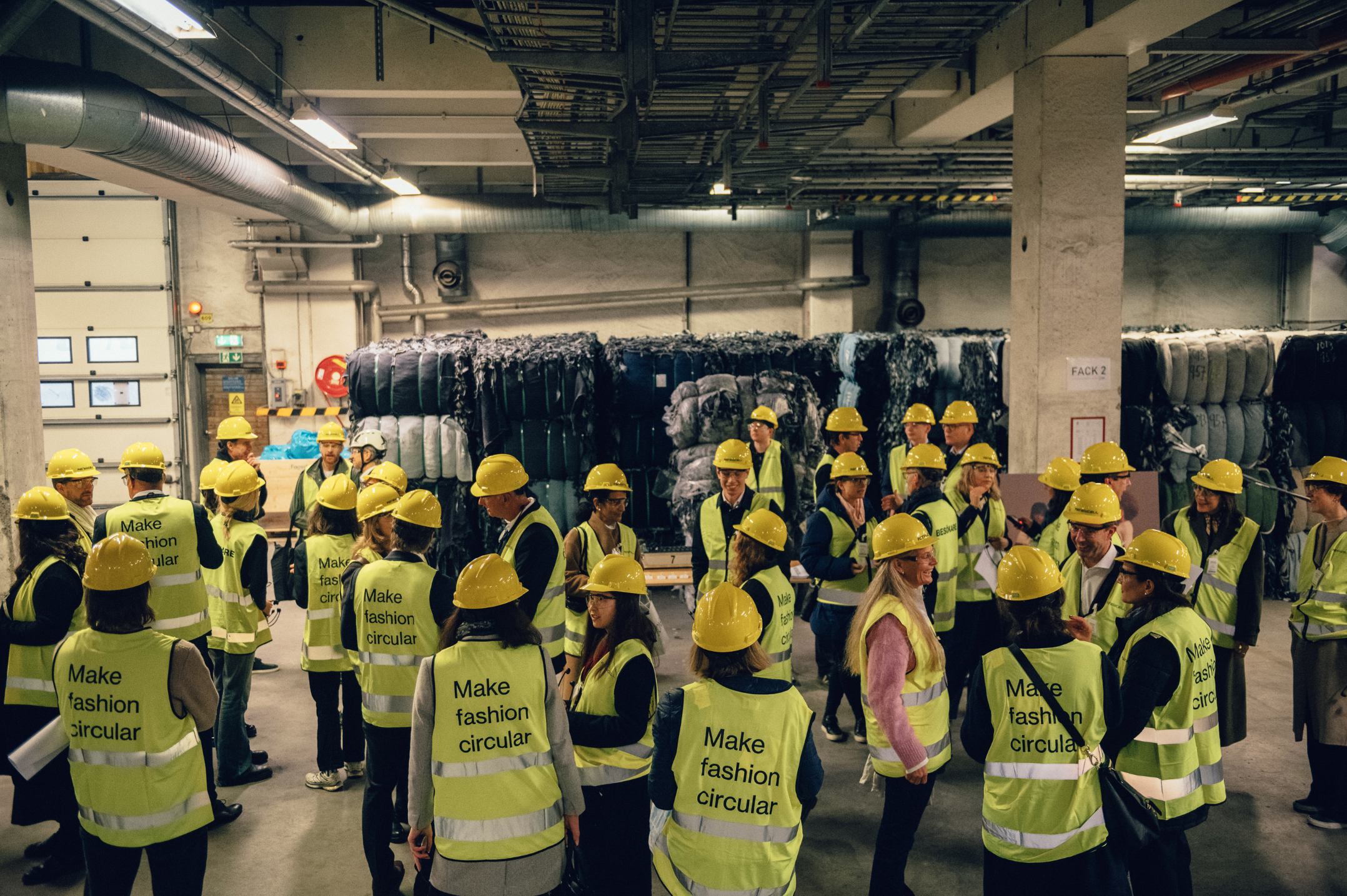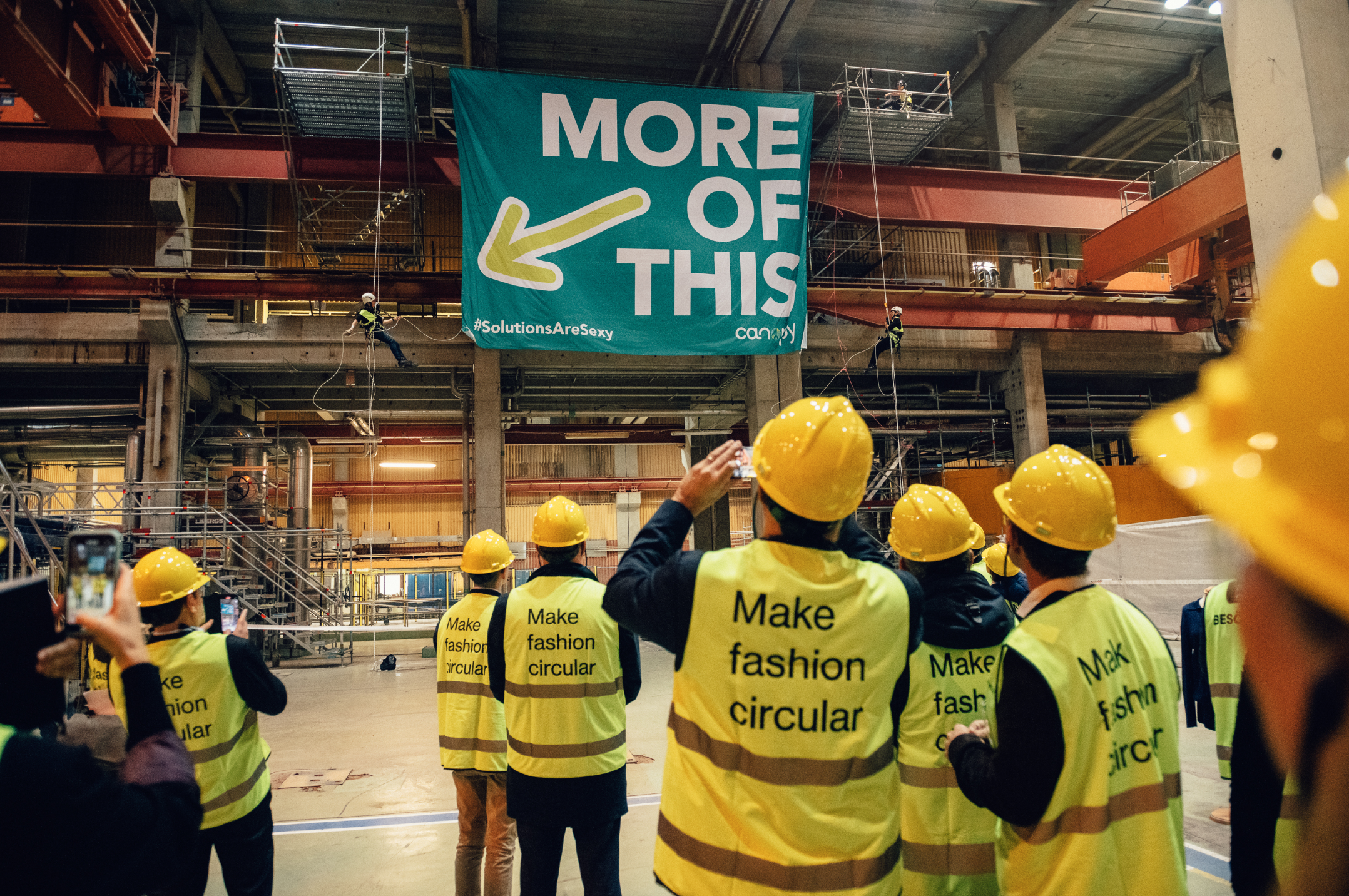

Yesterday, a factory producing textile fibre pulp opened in Sweden. Put another way, a factory turning textile waste into recycled textile fibres began commercial production. Or a more emphatic version would be: the world’s first textile recycling plant went online, signalling a new era in low-impact fibre production by turning cotton waste into perpetually recyclable fibres. Context is everything, and to understand the milestone of the ‘Renewcell 1’ recycling plant achieving commercial scale, I attended its inauguration in Sundsvall, Sweden.
Right now, world leaders are at COP27, discussing what to do about the climate crisis – a year after the last time they did this at COP26. During that time, emissions have risen, climate financing has faltered, and environmental commitments have yet to be honoured. Also, within the past year, Renewcell1 turned a decommissioned paper mill into a textile recycling plant with the capacity to process 175,000 bales of textile waste (each weighing 200-300kg) into dissolving pulp. This pulp (a dehydrated ‘cardboard’ of cellulose molecules derived from cotton waste) will generate 60,000 tonnes of circular textile fibres yearly. These circular fibres – ‘Circulose’ – would otherwise have come from logged trees. The fibre type is man-made cellulosic fibre (MMCF), commonly known as Lyocell, Tencel or viscose. The cotton textile waste used to make these recycled fibres would ordinarily be incinerated. In fact, by law, it must be burned in many locations; Prato (where many of Italy’s textile mills reside) is one such location.
I know this because Jodi Everding, VP of Sustainability at womenswear brand Filippa-K, explained during the tour that the brand’s Prato-based mill partner Beste2 was facing an expensive waste issue. They lamented to Everding that the linear and charred dead-end their waste meets costs the mill a considerable sum. Textile waste is a problem Filippa-K has also been trying to address across its entire value chain. During the tour of Renewcell 1, Everding explained that embedding long-term waste-reduction solutions for all stakeholders across their fibre, weaving, and cut and sew phases a key motivation for working with Renewcell. The partnership was solidified in the recent launch of their winter collection containing cotton and viscose (of which 30% is Circulose). “We are looking for [material] solutions that will scale,” she explained, making it clear that such solutions must be embedded in the materials they source season after season – part of the fabric’ palette’ at their disposal and not isolated material experiments.
Stakeholders across the value chain are steeped in the same waste challenges and accountable to the same rising regulations and the impending changes under the European Green deal and the Product Environmental Footprint calculator. Waste is being wasted, and it costs time, emissions and money, posing a growing climate and business risk.
Erik Karlsson was also on the plant tour. As a VC and Impact Investor at H&M CO: LAB, he’s primed to identify innovations that can help the H&M brand meet its impact reduction targets whilst satiating consumer appetites for fashion. He explained during a discussion that their investments must hit strategic and financial goals, and CO: LAB got in at the ground floor with Renewcell. Karlsson met the founding team in 2012 then invested in the company in 2017. H&M’s involvement, no doubt, generated interest and support for Renewcell’s eventual IPO in 2020. It’s been a “win-win” in impact reduction and ROI terms, Karlsson said after the plant tour. The brand uses large quantities of cellulose-based fibres (including cotton and viscose), making Renewcell’s commercial scaling instrumental in achieving H&M’s long-term textile impact reduction goals.
CanopyPlanet3 NGO’s Nicole Rycroft (Founder and Executive Director) and Valerie Langer (Consulting strategist) also ‘attended’ the tour by way of abseiling from the factory’s ceiling to foundations, simultaneously unravelling a banner marking Renewcell 1’s commercial status with the words: “More of This”. Indeed. Much more.

But how much more is the question, meaning much more circular waste pulp is needed to make a dent in the incumbent fibre production processes that log forests (especially ancient ones). CEO Patrik Lundström shared some figures that begin to answer this question. Right now, Renewcell’s fibre capacity is 60,000 metric tonnes per year. Except for one facet of the plant’s infrastructure (its shredding equipment), a capacity of 120,000 metric tonnes is possible. Funding is already in place to expand shredding capacity, and as soon as Renewcell 1 has been operational for long enough to de-risk a doubling of production volumes, it will be drawn down, according to company CFO Toby Lawton.
Lundström added that by 2030, technically, the Renewcell process could produce all the dissolving pulp needed for the industry (at the projected volume of 11M metric tonnes per year), but the expansion of recycling plants will dictate how much capacity Renewcell actually provides.
Additionally, Renewcell’s Circulose could take market share from both cotton and polyester (in addition to MMCFs), according to Lundström. His claim is extrapolated from Renewcell’s Levis partnership, where Circulose replaced 30% of the cotton in 501 jeans. The result? Circulose is effectively equivalent to cotton in the final product, matching it aesthetically and functionally. In the polyester realm, the CEO claims that Circulose could replace around 15% of synthetic fibre content in fleeces, lightweight jersey activewear and several other products. With synthetic fibres accounting for over half the fibre market – 113M tonnes in 2021, growing to 149M tonnes by 20304 – 15% of synthetics looks to be a great business expansion opportunity; it even exceeds the total projected MMCF market of 11M metric tonnes. As things stand, Lundström is aiming for 360,000 tonnes of Circulose fibre output per year by 2030, representing 0.5% of today’s MMCF market (7.2M metric tonnes in 2021).
So what’s the social and environmental gain from turning textile waste (post-industrial and post-consumer) into new fibres instead of cotton, wood or petrochemicals (in the case of synthetic fibres)? It’s a huge question requiring a very long and nuanced explanation from data that is difficult (perhaps impossible) to obtain, so for now, it makes sense to focus on the difference between dissolving pulp made from textile waste versus wood.
Impact reductions gained by using waste instead of wood include avoiding logging. Leaving trees standing clearly enables ongoing CO2 sequestration; however, this action, though straightforward, doesn’t provide failsafe data due to tree variety, age and surrounding ecological factors. A secondary benefit of using textile waste is that it avoids landfill, thereby eliminating the CO2 emitted during the biodegradation of cotton in ‘unmanaged’ landfill conditions (currently, most sites across the globe).
Beyond this, textile waste requires less chemical and mechanical processing than wood to extract cellulose, which is the component of the final fibre. Professor Mikael Lindström, a co-founder of Renewcell, explained that this affords Circulose enhanced strength due to higher cellulose content in the waste pulp. I will further explore this in a follow-up Innovator Spotlight to flesh out Circulose’s performance characteristics and detailed environmental credentials. Indicative figures provided by Patrik Lundström place incumbent MMCFs from wood at around 3kg of CO2 eq per kg and Circulose at -2kg. For those baulking at the negative footprint figure, when producing something, there is always an impact; I will also address this calculation method in the spotlight article.
Visiting a factory actioning reduced textile waste and environmental impacts is cause for hope – not least because Renewcell 1 was assembled and operational in under a year. It’s also a warning that vast (and swift) capacity building is needed because Circulose can’t keep pace with the growth of the fibre market, let alone displace a chunk of it. The next step must surely be replication. I will continue to cover the expansion of such recycling plants (some of which still need to be made public), so stay tuned. For now? COP27, cop this: a recycling plant turning hundreds of thousands of tonnes of waste into circular fibres got off the ground in less than 12 months. What’s your progress?







